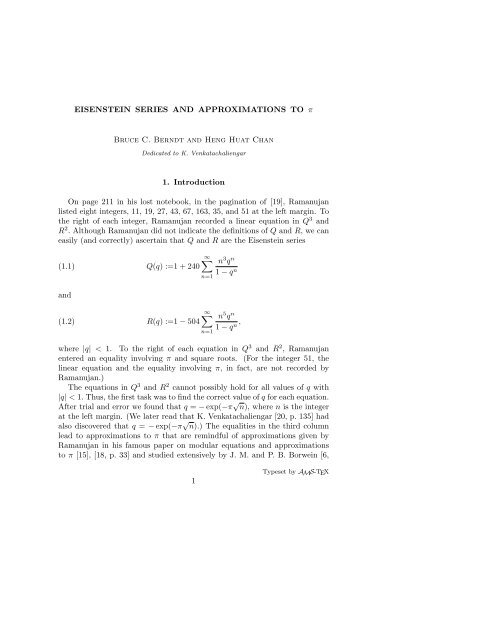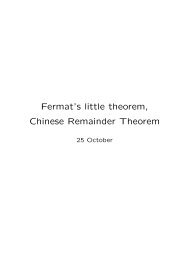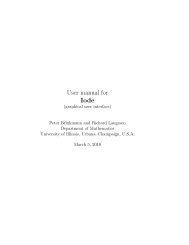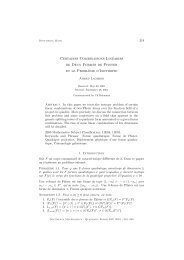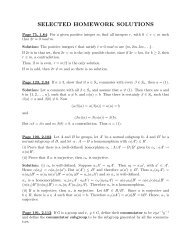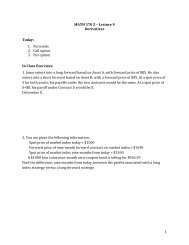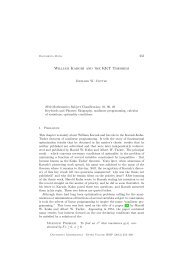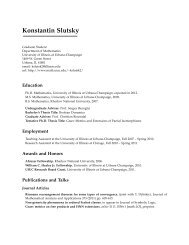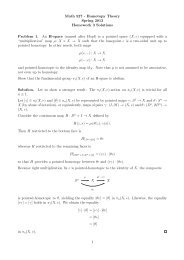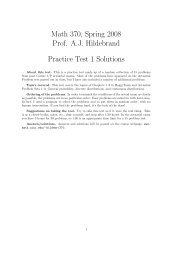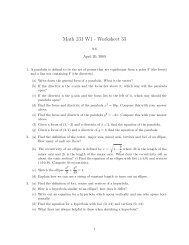Eisenstein series and approximations to pi - Mathematics
Eisenstein series and approximations to pi - Mathematics
Eisenstein series and approximations to pi - Mathematics
Create successful ePaper yourself
Turn your PDF publications into a flip-book with our unique Google optimized e-Paper software.
EISENSTEIN SERIES AND APPROXIMATIONS TO π<br />
Bruce C. Berndt <strong>and</strong> Heng Huat Chan<br />
Dedicated <strong>to</strong> K. Venkatachaliengar<br />
1. Introduction<br />
On page 211 in his lost notebook, in the pagination of [19], Ramanujan<br />
listed eight integers, 11, 19, 27, 43, 67, 163, 35, <strong>and</strong> 51 at the left margin. To<br />
the right of each integer, Ramanujan recorded a linear equation in Q 3 <strong>and</strong><br />
R 2 . Although Ramanujan did not indicate the definitions of Q <strong>and</strong> R, we can<br />
easily (<strong>and</strong> correctly) ascertain that Q <strong>and</strong> R are the <strong>Eisenstein</strong> <strong>series</strong><br />
(1.1)<br />
<strong>and</strong><br />
(1.2)<br />
Q(q) :=1 + 240<br />
R(q) :=1 − 504<br />
∞<br />
n=1<br />
∞<br />
n=1<br />
n 3 q n<br />
1 − q n<br />
n5qn ,<br />
1 − qn where |q| < 1. To the right of each equation in Q 3 <strong>and</strong> R 2 , Ramanujan<br />
entered an equality involving π <strong>and</strong> square roots. (For the integer 51, the<br />
linear equation <strong>and</strong> the equality involving π, in fact, are not recorded by<br />
Ramanujan.)<br />
The equations in Q 3 <strong>and</strong> R 2 cannot possibly hold for all values of q with<br />
|q| < 1. Thus, the first task was <strong>to</strong> find the correct value of q for each equation.<br />
After trial <strong>and</strong> error we found that q = − exp(−π √ n), where n is the integer<br />
at the left margin. (We later read that K. Venkatachaliengar [20, p. 135] had<br />
also discovered that q = − exp(−π √ n).) The equalities in the third column<br />
lead <strong>to</strong> <strong>approximations</strong> <strong>to</strong> π that are remindful of <strong>approximations</strong> given by<br />
Ramanujan in his famous paper on modular equations <strong>and</strong> <strong>approximations</strong><br />
<strong>to</strong> π [15], [18, p. 33] <strong>and</strong> studied extensively by J. M. <strong>and</strong> P. B. Borwein [6,<br />
1<br />
Typeset by AMS-TEX
2 BRUCE C. BERNDT AND HENG HUAT CHAN<br />
Chap. 5]. As will be seen, this page in the lost notebook is closely connected<br />
with theorems connected with the modular j-invariant stated by Ramanujan<br />
on the last two pages of his third notebook [10] <strong>and</strong> proved by the authors<br />
[4], [3, pp. 309–322].<br />
In Section 2, we prove a general theorem from which the linear equations<br />
in Q 3 <strong>and</strong> R 2 in the second column follow as corollaries. In Sections 3 <strong>and</strong> 4,<br />
we offer two methods for proving the equalities in the third column <strong>and</strong> show<br />
how they lead <strong>to</strong> <strong>approximations</strong> <strong>to</strong> π. Ramanujan’s equations for π lead in<br />
Section 4 <strong>to</strong> certain numbers tn (defined by (4.28)). The numbers tn guide us<br />
in Section 5 <strong>to</strong> a proof of a general <strong>series</strong> formula for 1/π, which is equivalent<br />
<strong>to</strong> a formula found by D. V. <strong>and</strong> G. V. Chudnovsky [13] <strong>and</strong> the Borweins [9].<br />
The first <strong>series</strong> representations for 1/π of this type were found by Ramanujan<br />
[15], [18, pp. 23–39] but first proved by the Borweins [8]. The work of the<br />
Borweins [6], [7], [8] <strong>and</strong> Chudnovskys [13] significantly extends Ramanujan’s<br />
work. One of Ramanujan’s <strong>series</strong> for 1/π yields 8 digits of π per term, while<br />
one of the Borweins [7] gives 50 digits of π per term. Our simpler method<br />
enables us in Section 5 <strong>to</strong> determine a <strong>series</strong> for 1/π which yields about 73 or<br />
74 digits of π per term.<br />
2. <strong>Eisenstein</strong> Series <strong>and</strong> the Modular j–invariant<br />
Recall the definition of the modular j–invariant j(τ),<br />
(2.1) j(τ) = 1728<br />
Q 3 (q)<br />
In particular, if n is a positive integer,<br />
√ <br />
3 + −n<br />
(2.2) j<br />
2<br />
where, for brevity, we set<br />
Q 3 (q) − R 2 (q) , q = e2πiτ , Im τ > 0.<br />
= 1728 Q3n Q3 n − R2 ,<br />
n<br />
(2.3) Qn := Q(−e −π√ n ) <strong>and</strong> Rn := R(−e −π√ n ).<br />
In his third notebook, at the <strong>to</strong>p of page 392 in the pagination of [17], Ramanujan<br />
defined a certain function Jn of singular moduli, which, as the authors [4]<br />
easily showed, has the representation<br />
(2.4) Jn = − 1<br />
<br />
√ <br />
3 3 + −n<br />
j<br />
.<br />
32 2<br />
Hence, from (2.2) <strong>and</strong> (2.4),<br />
(2.5) (−32Jn) 3 = 1728 Q3 n<br />
Q 3 n − R 2 n<br />
.<br />
After a simple manipulation of (2.5), we deduce the following theorem.
Theorem 2.1. For each positive integer n,<br />
8 <br />
(2.6)<br />
3 Jn<br />
APPROXIMATIONS TO π 3<br />
3<br />
+ 1<br />
Q 3 <br />
8<br />
n −<br />
3 Jn<br />
3 R 2 n = 0,<br />
where Jn is defined by (2.4), <strong>and</strong> Qn <strong>and</strong> Rn are defined by (2.3).<br />
Examples 2.2 ([19, p. 211]). We have<br />
<strong>and</strong><br />
539Q 3 11 − 512R 2 11 =0,<br />
(8 3 + 1)Q 3 19 − 8 3 R 2 19 =0,<br />
(40 3 + 9)Q 3 27 − 40 3 R 2 27 =0,<br />
(80 3 + 1)Q 3 43 − 80 3 R 2 43 =0,<br />
(440 3 + 1)Q 3 67 − 440 3 R 2 67 =0,<br />
(53360 3 + 1)Q 3 163 − 53360 3 R 2 163 =0,<br />
((60 + 28 √ 5) 3 + 27)Q 3 35 − (60 + 28 √ 5) 3 R 2 35 =0,<br />
((4(4 + √ 17) 2/3 (5 + √ 17)) 3 + 1)Q 3 51 − (4(4 + √ 17) 2/3 (5 + √ 17)) 3 R 2 51 = 0.<br />
Proof. In [4], [3, pp. 310, 311], we showed that<br />
(2.7)<br />
⎧<br />
J11 =1,<br />
⎪⎨<br />
J67 =165,<br />
⎪⎩ J35 = √ <br />
1 +<br />
5<br />
√ 4 5<br />
,<br />
2<br />
J27 =5 · 3 1/3 ,<br />
J19 =3,<br />
J43 =30,<br />
J163 =20, 010,<br />
J51 =3(4 + √ 17) 2/3<br />
<br />
5 + √ <br />
17<br />
.<br />
2<br />
Using (2.7) in (2.6), we readily deduce all eight equations in Qn <strong>and</strong> Rn.<br />
3. <strong>Eisenstein</strong> Series <strong>and</strong> Equations in π - First Method<br />
Define, after Ramanujan,<br />
(3.1) P (q) := 1 − 24<br />
∞<br />
n=1<br />
nqn , |q| < 1,<br />
1 − qn
4 BRUCE C. BERNDT AND HENG HUAT CHAN<br />
<strong>and</strong> put<br />
(3.2) Pn := P (−e −π√ n ).<br />
Next, set<br />
(3.3) bn = {n(1728 − jn)} 1/2<br />
<strong>and</strong><br />
(3.4) an = 1<br />
6 bn<br />
<br />
1 − Qn<br />
<br />
Pn −<br />
Rn<br />
6<br />
π √ <br />
.<br />
n<br />
The numbers an <strong>and</strong> bn arise in <strong>series</strong> representations for 1/π proved by the<br />
Chudnovskys [13] <strong>and</strong> the Borweins [8], namely,<br />
(3.5)<br />
1 1<br />
= √<br />
π −jn<br />
∞<br />
k=0<br />
(6k)!<br />
(3k)!(k!) 3<br />
an + kbn<br />
jk ,<br />
n<br />
where (c)0 = 1, (c)k = c(c + 1) · · · (c + k − 1), for k ≥ 1, <strong>and</strong><br />
√ <br />
3 + −n<br />
jn = j<br />
.<br />
2<br />
These authors have calculated an <strong>and</strong> bn for several values of n, but we are<br />
uncertain if these calculations are theoretically grounded. We show how (3.3)<br />
<strong>and</strong> (3.4) lead <strong>to</strong> a formula from which Ramanujan’s equalities in the third<br />
column on page 211 follow.<br />
From (2.6), we easily see that<br />
(3.6)<br />
Qn<br />
Rn<br />
<strong>and</strong> from (3.4), we find that<br />
(3.7)<br />
Qn<br />
Rn<br />
= 1<br />
<br />
8<br />
√<br />
Qn<br />
3 Jn<br />
8<br />
3 Jn<br />
3 + 1<br />
3<br />
−1/2<br />
<br />
6<br />
π − √ <br />
nPn = 6 √ n an<br />
−<br />
bn<br />
√ n.<br />
The substitution of (3.6) in<strong>to</strong> (3.7) leads <strong>to</strong> the following theorem.<br />
,
APPROXIMATIONS TO π 5<br />
Theorem 3.1. If Pn, bn, an, <strong>and</strong> Jn are defined by (3.2)–(3.4) <strong>and</strong> (2.4),<br />
respectively, then<br />
(3.8)<br />
1<br />
√ Qn<br />
<br />
√nPn<br />
− 6<br />
<br />
=<br />
π<br />
√ <br />
n 1 − 6 an<br />
<br />
bn<br />
<br />
8<br />
Examples 3.2 ([19, p. 211]). We have<br />
3 Jn<br />
8<br />
3 Jn<br />
3 + 1<br />
<br />
1 √11P11 √ −<br />
Q11<br />
6<br />
<br />
=<br />
π<br />
√ 2,<br />
<br />
1 √19P19 √ −<br />
Q19<br />
6<br />
<br />
=<br />
π<br />
√ 6,<br />
<br />
1 √27P27 √ −<br />
Q27<br />
6<br />
<br />
6<br />
=3<br />
π 5 ,<br />
<br />
1 √43P43 √ −<br />
Q43<br />
6<br />
<br />
3<br />
=6<br />
π 5 ,<br />
<br />
1 √67P67 √ −<br />
Q67<br />
6<br />
<br />
6<br />
=19<br />
π 55 ,<br />
<br />
1 √163P163 √ −<br />
Q163<br />
6<br />
<br />
3<br />
=362<br />
π 3335 ,<br />
<br />
1 √35P35 √ −<br />
Q35<br />
6<br />
<br />
=(2 +<br />
π<br />
√ <br />
2<br />
5) √ ,<br />
5<br />
<br />
1 √51P51 √ −<br />
Q51<br />
6<br />
<br />
=.<br />
π<br />
3<br />
1/2<br />
Ramanujan’s formulation of the first example of Examples 3.2 is apparently<br />
given by<br />
√ 6<br />
11 − + · · ·<br />
π<br />
3 1<br />
1 − 240 · · ·<br />
= √ 2.<br />
e π√ 11<br />
(The denomina<strong>to</strong>r with 1 3 in the numera<strong>to</strong>r is unreadable.) Further equalities<br />
are even briefer, with √ Qn replaced by √ ·. Note that Pn is replaced by<br />
“1 + · · · ” in Ramanujan’s examples. Also observe that Ramanujan did not<br />
record the right side when n = 51. Because it is unwieldy, we also have not<br />
.
6 BRUCE C. BERNDT AND HENG HUAT CHAN<br />
recorded it. However, readers can readily complete the equality, since J51 is<br />
given in (2.7) <strong>and</strong> a51 <strong>and</strong> b51 are given in the next table.<br />
Proof. The first six values of an <strong>and</strong> bn were calculated by the Borweins [8,<br />
pp. 371, 372]. The values for n = 35 <strong>and</strong> 51 were calculated by the present<br />
authors. We record all 8 pairs of values for an <strong>and</strong> bn in the following table.<br />
n an bn<br />
11 60 616<br />
19 300 4104<br />
27 1116 18216<br />
43 9468 195048<br />
67 122124 3140424<br />
163 163096908 6541681608<br />
35 1740 + 768 √ 5 32200 + 14336 √ 5<br />
51 11820 + 2880 √ 17 265608 + 64512 √ 17<br />
If we substitute these values of an <strong>and</strong> bn in Theorem 3.1, we obtain, after<br />
some calculation <strong>and</strong> simplification, Ramanujan’s equalities.<br />
Theorem 3.1 <strong>and</strong> the last set of examples yield <strong>approximations</strong> <strong>to</strong> π. Let<br />
rn denote the algebraic expression on the right side in (3.8). If we use the<br />
expansions<br />
Pn = 1 + 24e −π√ n − · · · <strong>and</strong> Qn = 1 − 120e −π√ n + · · · ,<br />
we easily find that<br />
π =<br />
<br />
6<br />
√<br />
n − rn<br />
1 − 24√n + 120rn<br />
√<br />
n − rn<br />
We thus have proved the following theorem.<br />
Theorem 3.3. We have<br />
π ≈<br />
with the error approximately equal <strong>to</strong><br />
6<br />
√ =: An,<br />
n − rn<br />
√<br />
n + 5rn<br />
144<br />
( √ n − rn) 2 e−π√ n<br />
,<br />
e −π√ <br />
n<br />
+ · · · .
APPROXIMATIONS TO π 7<br />
where rn is the algebraic expression on the right side in (3.8).<br />
See Ramanujan’s paper [15], [18, p. 33] for other <strong>approximations</strong> <strong>to</strong> π of<br />
this sort.<br />
In the table below, we record the decimal expansion of each approximation<br />
An <strong>and</strong> the number Nn of digits of π agreeing with the approximation.<br />
n An Nn<br />
11 3.1538 . . . 1<br />
19 3.1423 . . . 2<br />
27 3.1416621 . . . 3<br />
43 3.141593 . . . 5<br />
67 3.14159266 . . . 7<br />
163 3.14159265358980 . . . 12<br />
35 3.141601 . . . 3<br />
51 3.14159289 . . . 6<br />
4. <strong>Eisenstein</strong> Series <strong>and</strong> Equations in π - Second Method<br />
Set P := P(q) := P (−q), Q := Q(q) := Q(−q), R := R(q) := R(−q),<br />
∆ := ∆(q) := Q3 (q)−R2 (q), <strong>and</strong> J := J(q) := 1728/j <br />
3+τ<br />
2πiτ<br />
2 , where q = e .<br />
Set<br />
(4.1) z 4 := Q =<br />
1/3 ∆<br />
,<br />
J<br />
by (2.1). Then, by (4.1) <strong>and</strong> the definition of ∆,<br />
(4.2) R = Q 3 − ∆ =<br />
<br />
∆√<br />
6<br />
1 − J = z<br />
J<br />
√ 1 − J.<br />
Recall the differential equations [16], [17, p. 142]<br />
(4.3)<br />
q dP<br />
dq = P 2 (q) − Q(q)<br />
, q<br />
12<br />
dQ P (q)Q(q) − R(q)<br />
= , q<br />
dq 3<br />
dR<br />
dq = P (q)R(q) − Q2 (q)<br />
,<br />
2<br />
which yield the associated differential equations<br />
(4.4)<br />
q dP<br />
dq = P2 (q) − Q(q)<br />
, q<br />
12<br />
dQ P(q)Q(q) − R(q)<br />
= , q<br />
dq 3<br />
dR<br />
dq = P(q)R(q) − Q2 (q)<br />
.<br />
2
8 BRUCE C. BERNDT AND HENG HUAT CHAN<br />
Now, by rearranging the second equation in (4.4), with the help of (4.1)<br />
<strong>and</strong> (4.2), we find that<br />
(4.5) P(q) = R(q) 12q dz<br />
+<br />
Q(q) z dq .<br />
From the chain rule <strong>and</strong> (4.5), it follows that, for any positive integer n,<br />
P(q n ) = R(qn )<br />
Q(qn 12q<br />
+<br />
) nz(qn )<br />
Subtracting (4.5) from the last equality <strong>and</strong> setting<br />
we find that<br />
(4.6)<br />
nP(q n ) − P(q) =n R(qn )<br />
Q(qn R(q)<br />
−<br />
) Q(q)<br />
m := z(q)<br />
z(q n ) ,<br />
q<br />
+ 12<br />
z(qn )<br />
=n R(qn )<br />
Q(qn R(q) q dm<br />
− − 12<br />
) Q(q) m dq .<br />
dz(qn )<br />
.<br />
dq<br />
dz(q n )<br />
dq<br />
q dz(q)<br />
− 12<br />
z(q) dq<br />
Our next aim is <strong>to</strong> replace dm<br />
dm<br />
in (4.6) by<br />
dq dJ (J(q), J(qn )). From (2.1),<br />
the definition of J, (4.4), (4.1), <strong>and</strong> (4.2), upon differentiation, we find that<br />
(4.7)<br />
q dJ<br />
dq =(3Q2 Q ′ − 2RR ′ )Q3 − 3Q2Q ′ (Q3 − R2 )<br />
Q6 = {Q2 (PQ − R) − R(PR − Q 2 )}Q 3 − Q 2 (PQ − R)(Q 3 − R 2 )<br />
Q 6<br />
= RQ3 − R 3<br />
Q 4<br />
which implies that<br />
= R∆<br />
Q 4 = z6√ 1 − J J<br />
Q = z2 J √ 1 − J,<br />
(4.8) z 2 1<br />
(q) =<br />
J(q) dJ(q)<br />
q<br />
1 − J(q) dq .<br />
Replacing q by q n in (4.8) <strong>and</strong> simplifying, we deduce that<br />
(4.9) z 2 (q n ) =<br />
1<br />
nJ(qn ) 1 − J(qn ) q dJ(qn )<br />
.<br />
dq
Using (4.8) <strong>and</strong> (4.9), we conclude that<br />
(4.10) m 2 = n J(qn ) 1 − J(q n )<br />
J(q) 1 − J(q)<br />
APPROXIMATIONS TO π 9<br />
dJ(q)<br />
dJ(qn ) .<br />
It is well known that there is a relation (known as the class equation) between<br />
j(τ) <strong>and</strong> j(nτ) for any integer n [14, p. 231, Theorem 11.18(i)]. With<br />
the definition of J given at the beginning of this section, the class equation<br />
translates <strong>to</strong> a relation between J(q) <strong>and</strong> J(q n ). It follows that,<br />
(4.11)<br />
dJ(q)<br />
dJ(q n ) = F (J(q), J(qn )),<br />
for some rational function F (x, y). Thus, by (4.10) <strong>and</strong> (4.11), we may differentiate<br />
m with respect <strong>to</strong> J, <strong>and</strong> so, by (4.7) <strong>and</strong> the definition of m(q),<br />
2 q dm<br />
m(q) dq = 2z(q)z(qn )<br />
Using this in (4.6), we deduce that<br />
(4.12)<br />
nP(q n ) − P(q)<br />
z(q)z(q n )<br />
q<br />
z2 (q)<br />
dm<br />
dq<br />
= 2z 2 (q n )m(q) dm dJ<br />
q<br />
dJ dq = z2 (q n )J √ 1 − J dm2 (q)<br />
dJ .<br />
= n R(qn )<br />
Q(qn R(q)<br />
−<br />
) Q(q) − 6z2 (q n )J(q) 1 − J(q) dm2<br />
dJ .<br />
If we put q = e −π/√ n , n > 0, (4.12) takes the shape<br />
nP(e −π√n −π/<br />
) − P(e √ n R(e<br />
) =n −π√n )<br />
Q(e−π√ −<br />
n ) R(e−π/√ n )<br />
Q(e−π/√n )<br />
− 6z 2 (e −π√n −π/<br />
)J(e √ <br />
n<br />
) 1 − J(e−π/√n )<br />
× dm2<br />
<br />
J(e<br />
dJ<br />
−π√n −π/<br />
), J(e √ <br />
n<br />
(4.13)<br />
) .<br />
It is well known that [12, p. 84]<br />
(4.14) J(e −π/√ n ) = J(e −π √ n ).<br />
Furthermore, if<br />
(4.15) ϕ(q) =<br />
∞<br />
n=−∞<br />
q n2<br />
<strong>and</strong> ψ(q) =<br />
∞<br />
q n(n+1)/2 , |q| < 1,<br />
n=0
10 BRUCE C. BERNDT AND HENG HUAT CHAN<br />
then [2, p. 127, Entries 13(iii), (iv)],<br />
(4.16)<br />
<strong>and</strong><br />
(4.17)<br />
Q(q) = z 4 2(1 + 14x2 + x 2 2),<br />
R(q) = z 6 2(1 + x2)(1 − 34x2 + x 2 2),<br />
where [2, p. 122–123, Entries 10(i), 11(iii)]<br />
(4.18) z2 := ϕ 2 (q) <strong>and</strong> x2 := 16q ψ4 (q 2 )<br />
ϕ 4 (q) .<br />
Replacing q by −q in (4.16) <strong>and</strong> (4.17), <strong>and</strong> using (4.18), we find that<br />
(4.19)<br />
<strong>and</strong><br />
(4.20)<br />
Q(q) = ϕ 8 (−q) − 224qϕ 4 (−q)ψ 4 (q 2 ) + 16 2 q 2 ψ 8 (q 2 )<br />
R(q) = (ϕ 4 (−q) − 16qψ 4 (q 2 ))<br />
× (ϕ 8 (−q) + 544qϕ 4 (−q)ψ 4 (q 2 ) + 16 2 q 2 ψ 8 (q 2 )).<br />
Using the transformation formula [2, p. 43, Entry 27(ii)],<br />
in (4.19) <strong>and</strong> (4.20), we deduce that<br />
(4.21)<br />
<strong>and</strong><br />
(4.22)<br />
ϕ(e −π/t ) = 2e −πt/4√ tψ(e −2πt )<br />
R(e −π/√ n ) = −n 3 R(e −π √ n )<br />
Q(e −π/√ n ) = n 2 Q(e −π √ n ).<br />
Using (4.14), (4.21), <strong>and</strong> (4.22), we may rewrite (4.13) as<br />
nP(e −π√n −π/<br />
) − P(e √ n<br />
)<br />
= 2n R(e−π√ n )<br />
Q(e−π√ − 6z<br />
n ) 2 (e −π√ <br />
n dm<br />
)Jn 1 − J1/n 2<br />
dJ (Jn, Jn) ,<br />
<br />
= 2n <br />
dm<br />
1 − Jn − 6Jn 1 − J1/n 2<br />
dJ (Jn,<br />
<br />
(4.23)<br />
Jn)<br />
z 2 (e −π√ n ),
where<br />
APPROXIMATIONS TO π 11<br />
(4.24) Jk = J(e −π√ k ), k > 0.<br />
This gives the first relation between P(e −π√ n ) <strong>and</strong> P(e −π/ √ n ).<br />
Recall the definitions of Ramanujan’s function f(−q) <strong>and</strong> the Dedekind<br />
eta-function η(τ), namely,<br />
f(−q) :=<br />
∞<br />
(1 − q k ) =: e −2πiτ/24 η(τ), q = e 2πiτ , Im τ > 0.<br />
k=1<br />
The function f satisfies the well-known transformation formula [2, p. 43]<br />
(4.25) n 1/4 e −π√ n/24 f(e −π √ n ) = e −π/(24 √ n) f(e −π/ √ n ), n > 0.<br />
Logarithmically differentiating (4.25) with respect <strong>to</strong> n, multiplying both sides<br />
by 48n 3/2 /π, rearranging terms, <strong>and</strong> employing the definition of P (q) given<br />
in (3.1), we find that<br />
(4.26)<br />
12 √ n<br />
π = nP(e−π√ n ) + P(e −π/ √ n ).<br />
This gives a second relation between P(e −π√ n ) <strong>and</strong> P(e −π/ √ n ).<br />
Now adding (4.23) <strong>and</strong> (4.26) <strong>and</strong> dividing by 2, we arrive at<br />
nP(e −π√n 6<br />
) = √ n<br />
π +<br />
<br />
n <br />
dm<br />
1 − Jn − 3Jn 1 − J1/n 2<br />
dJ (Jn,<br />
<br />
Jn) z 2 (e −π√n ),<br />
or, by (4.1),<br />
<br />
1<br />
√ Pn −<br />
Qn<br />
6<br />
<br />
√ =<br />
nπ<br />
<br />
1 − J1/n<br />
1 − Jn 1 − 3Jn<br />
n √ dm<br />
1 − Jn<br />
2<br />
dJ (Jn,<br />
<br />
Jn) ,<br />
where Qn is defined by (2.3), <strong>and</strong> Pn is defined by (3.2). (Be careful; Jn = Jn,<br />
where Jn is defined by (2.4).)<br />
We record the last result in the following theorem, which should be compared<br />
with Theorem 3.1.<br />
Theorem 4.1. If Pn, Qn, <strong>and</strong> Jn<br />
respectively, then<br />
are defined by (3.2), (2.3), <strong>and</strong> (4.24),<br />
(4.27)<br />
<br />
1<br />
√ Pn −<br />
Qn<br />
6<br />
<br />
√ =<br />
nπ<br />
1 − Jntn,
12 BRUCE C. BERNDT AND HENG HUAT CHAN<br />
where<br />
<br />
1 − J1/n<br />
(4.28) tn := 1 − 3Jn<br />
n √ 1 − Jn<br />
Observe that, by (4.1), (4.2), <strong>and</strong> Theorem 2.1,<br />
(4.29)<br />
1 − Jn =<br />
<br />
8<br />
3Jn <br />
8<br />
3Jn 3 dm2 dJ (Jn,<br />
<br />
Jn) .<br />
3 + 1<br />
1/2<br />
Hence, the values of √ 1 − Jn for those n given on page 211 of the Lost Notebook<br />
follow immediately from (2.7). In order <strong>to</strong> rederive Examples 3.2, it<br />
suffices <strong>to</strong> compute tn.<br />
Theorem 4.2. If n > 1 is an odd positive integer, then tn lies in the ring<br />
class field of Z[ √ −n].<br />
Proof. By differentiating (4.10) with respect <strong>to</strong> J(q), we conclude that<br />
(4.30)<br />
dm2 dJ(q) =<br />
<br />
1 − J(qn )<br />
G(J(q), J(q<br />
1 − J(q) n )),<br />
for some rational function G(J(q), J(q n )). Using (4.28) <strong>and</strong> (4.30), we find<br />
that tn can be expressed in terms of Jn. Since Jn is in the ring class field<br />
of Z[ √ −n] when n > 1 is odd <strong>and</strong> squarefree [14, p. 220, Theorem 11.1], we<br />
complete our proof.<br />
An equivalent form of Theorem 4.2 is first mentioned without proof <strong>and</strong><br />
conditions on n by the Chudnovskys on page 391 of [13].<br />
Theorem 4.2 allows us <strong>to</strong> devise an em<strong>pi</strong>rical process for deriving tn whenever<br />
the class group of Q( √ −n) is of the type Zr 2, r ∈ N, where r = 0 refers <strong>to</strong><br />
imaginary quadratic fields with class number 1. By (3.6), (4.27), <strong>and</strong> (4.29),<br />
we find that<br />
(4.31) tn = Qn<br />
<br />
Pn − 6<br />
<br />
√ .<br />
nπ<br />
Rn<br />
When r = 0, we numerically compute the right h<strong>and</strong> side of (4.31) using the<br />
definitions of Pn, Qn, <strong>and</strong> Rn, <strong>and</strong> then using the comm<strong>and</strong> “minpoly(tn,1)”<br />
on the computer algebra system MAPLE V, we derive the values of tn for<br />
n = 3, 7, 11, 19, 27, 43, 67 <strong>and</strong> 163. We summarize our findings in the following<br />
table.<br />
.
APPROXIMATIONS TO π 13<br />
n tn<br />
3 0<br />
5<br />
7<br />
21<br />
32<br />
11<br />
77<br />
32<br />
19<br />
57<br />
160<br />
27<br />
253<br />
640<br />
43<br />
903<br />
67<br />
163<br />
33440<br />
43617<br />
77265280<br />
90856689<br />
When r = 1, we are in a situation where tn satisfies a polynomial of degree<br />
2. We use the comm<strong>and</strong> “minpoly(tn,2)” <strong>and</strong> derive the resulting polynomial<br />
satisfied by tn. Using this method, we could, in particular, determine tn for<br />
n = 35 <strong>and</strong> 51, namely,<br />
t35 = 1504 + 576√ 5<br />
4123<br />
<strong>and</strong> t51 = 144<br />
329 + 400√ 17<br />
5593 .<br />
Using the values of tn given in the tables above <strong>and</strong> Theorem 4.1, we rederive<br />
Examples 3.2.<br />
So far, our method is still similar <strong>to</strong> that of the Borweins <strong>and</strong> Chudnovskys.<br />
Of course, we could continue <strong>to</strong> use “minpoly” <strong>and</strong> derive minimal polynomials<br />
satisfied by tn for r = 2, 3, <strong>and</strong> 4. However, this means that we have <strong>to</strong> solve<br />
polynomials of degress 4, 8, <strong>and</strong> 16, respectively, which is cumbersome when<br />
the degree of the polynomial exceeds 4. We now describe a new process for<br />
deriving tn, for r > 1. We illustrate our method using n = 21.<br />
When n = 21, we numerically compute t21 <strong>and</strong> t 7/3 <strong>and</strong> use “minpoly” <strong>to</strong><br />
deduce that<br />
<strong>and</strong><br />
Solving for t21 yields<br />
t21 + t7/3 = 30493 3820 √<br />
+ 7<br />
34279 34279<br />
√<br />
3(t21 − t7/3) = 28800 1935 √<br />
+ 7.<br />
34279 34279<br />
t21 = 30493 645 √ 4800 √ 1910 √<br />
+ 21 + 3 − 7.<br />
68558 68558 34279 34279
14 BRUCE C. BERNDT AND HENG HUAT CHAN<br />
The largest n for which tn can be computed using this new em<strong>pi</strong>rical<br />
method is n = 3315, namely,<br />
t3315 := 1095255033002752301233099478037584<br />
2050242335692983321671746996556833<br />
+ 1006588064225996719872149534306400 √ √<br />
17 5<br />
34854119706780716468419698941466161<br />
+ 692779168175128551453280427070000 √<br />
17<br />
34854119706780716468419698941466161<br />
− 136434536163779492503565618457696 √<br />
5<br />
2050242335692983321671746996556833<br />
+ 400179322879781860521299209248000 √<br />
13<br />
26653150364008783181732710955238829<br />
+ 1077564413015882021519209726762688 √ √ √<br />
13 17 5<br />
453103556188149314089456086239060093<br />
+ 120226784218523863048087030809600 √ √<br />
17 13<br />
64729079455449902012779440891294299<br />
+ 239369594240980944219359445009600 √ √<br />
13 5.<br />
26653150364008783181732710955238829<br />
This value is deduced from determining the quadratic numbers<br />
t3315 + t 1105/3 + t 663/5 + t 221/15,<br />
√ 221(t3315 − t 1105/3 + t 663/5 − t 221/15),<br />
√ 13(t3315 + t 1105/3 − t 663/5 − t 221/15),<br />
<strong>and</strong> √ 5(t3315 − t 1105/3 − t 663/5 + t 221/15)<br />
in Q( √ 85). We show in the next section that knowledge of t3315 <strong>and</strong> J3315<br />
leads <strong>to</strong> a new <strong>series</strong> for 1/π which converges at a rate of 73/74 decimal places
APPROXIMATIONS TO π 15<br />
per term. This <strong>series</strong> appears <strong>to</strong> be the fastest known convergent <strong>series</strong> for<br />
1/π which involves quadratic radicals. The previous fastest convergent <strong>series</strong>,<br />
giving 50 decimal places per term, was obtained by the Borweins [8]. Their<br />
<strong>series</strong> involves quartic radicals which arise from the field Q( √ −1555), which<br />
has class number 4.<br />
5. tn, Jn <strong>and</strong> the Ramanujan–Borweins–Chudnovskys <strong>series</strong> for 1/π<br />
Let ϕ(q) <strong>and</strong> ψ(q) be given as in (4.15), <strong>and</strong> recall the definition of the<br />
hypergeometric function 2F1,<br />
2F1(a, b; c; u) :=<br />
∞ (a)k(b)k<br />
k=0<br />
(c)k<br />
uk , |u| < 1.<br />
k!<br />
In [20], using Ramanujan’s differential equations (4.3) <strong>and</strong> the relations<br />
Q(q 2 ) = z 4 2(1 − x2 + x 2 2) <strong>and</strong> R(q 2 ) = z 6 2(1 + x2)(1 − 2x2)(1 − x2/2),<br />
where z2 <strong>and</strong> x2 are given by (4.18), Venkatachaliengar proved the inversion<br />
formula<br />
z2 = 2F1( 1 1<br />
2 , 2 ; 1; x2).<br />
His method can be applied whenever we have relations of the form<br />
Q(q) = z 4 F (x) <strong>and</strong> R(q) = z 6 G(x),<br />
for some function z <strong>and</strong> x. The relations (4.1) <strong>and</strong> (4.2) indicate that we are<br />
in such a situation with z := Q <strong>and</strong> x := J. Invoking Venkatachaliengar’s<br />
method (see [11], [10] for examples of such calculations), we readily deduce<br />
that<br />
(5.1) z = 2F1( 1 5<br />
12 , 12 ; 1; J).<br />
We are now ready <strong>to</strong> give a proof of an equivalent form of the general <strong>series</strong><br />
for 1/π given by (3.5). As far as we know, a proof of this <strong>series</strong> has never<br />
been written down in the literature. First, by Clausen’s formula [1, p. 116],<br />
we find that<br />
(5.2) z 2 = 2F1( 1 5<br />
12 ,<br />
where<br />
3F2(a, b, c; d, e; u) =<br />
12 ; 1; J) 2<br />
= 3F2( 1<br />
6<br />
∞ (a)k(b)k(c)k<br />
k=0<br />
(d)k(e)k<br />
5 1 , 6 , 2 ; 1, 1; J),<br />
uk , |u| < 1.<br />
k!
16 BRUCE C. BERNDT AND HENG HUAT CHAN<br />
This implies, by (5.1), that<br />
(5.3) 2z dz<br />
dJ =<br />
where<br />
Ak :=<br />
By (4.5) <strong>and</strong> (4.7), we deduce that<br />
(5.4) 2z dz 1<br />
=<br />
dJ 6J<br />
∞<br />
AkkJ k−1 ,<br />
k=1<br />
<br />
1<br />
6 k<br />
<br />
5<br />
6 k<br />
(k!) 3<br />
<br />
1<br />
2<br />
k<br />
<br />
P<br />
√ − z<br />
1 − J 2<br />
<br />
.<br />
Substituting (5.4) in<strong>to</strong> (5.3) <strong>and</strong> using (5.2), we deduce that<br />
(5.5)<br />
P<br />
√ 1 − J =<br />
∞<br />
Ak(6k + 1)J k .<br />
k=0<br />
Next, set q = e −π√ n <strong>and</strong> deduce from (5.5) that<br />
(5.6)<br />
Pn<br />
√ =<br />
1 − Jn<br />
∞<br />
Ak(6k + 1)J k n.<br />
k=0<br />
On the other h<strong>and</strong>, by Theorem 4.1 <strong>and</strong> (4.1),<br />
(5.7) Pn = 6<br />
π √ n + z2 <br />
n 1 − Jntn.<br />
Using (5.7), (5.2) (with z replaced by zn <strong>and</strong> J replaced by Jn) <strong>and</strong> (5.6), we<br />
conclude that<br />
6 1<br />
(5.8) √ √<br />
n 1 − Jn π =<br />
∞<br />
<br />
1 5 1<br />
6 k 6 k 2 k<br />
(k!) 3 J k n(6k + 1 − tn).<br />
k=0<br />
It can be shown that (5.8) is equivalent <strong>to</strong> the Ramanujan–Borweins–Chudnovskys<br />
<strong>series</strong>. The <strong>series</strong> (5.8) enables us <strong>to</strong> write down for each n, a <strong>series</strong> for<br />
1/π if we know the values of tn <strong>and</strong> Jn.<br />
We have already determined the value of t3315 in Section 4. It suffices<br />
<strong>to</strong> compute J3315 in order <strong>to</strong> write down a <strong>series</strong> for 1/π associated with<br />
n = 3315. We first quote the identity [4], [5]<br />
√ <br />
3 + −3n<br />
(5.9) j<br />
2<br />
= −27 (λ2n − 1)(9λ2 n − 1) 3<br />
λ2 ,<br />
n<br />
.
where<br />
APPROXIMATIONS TO π 17<br />
λn = eπ√ n/2<br />
3 √ 3<br />
f 6 (e −π√ n/3 )<br />
f 6 (e −π√ 3n ) ,<br />
where f(−q) is defined prior <strong>to</strong> (4.25). Since [5]<br />
λ 2 1105 =<br />
√ 5 + 1<br />
2<br />
24<br />
(4 + √ 17) 6<br />
<br />
15 + √ 6 221<br />
(8 +<br />
2<br />
√ 65) 6 ,<br />
the value of J3315 follows immediately from (5.9). The values J3315 <strong>and</strong> t3315,<br />
when substituted in<strong>to</strong> (5.8), yield the <strong>series</strong> which we mentioned at the end<br />
of Section 4.<br />
Acknowledgement. We are grateful <strong>to</strong> Seung Hwan Son for hel<strong>pi</strong>ng us find the<br />
correct value of q for the linear equations in Q 3 <strong>and</strong> R 2 . The first author is<br />
grateful <strong>to</strong> the National University of Singapore for financially supporting his<br />
visit there when this research was conducted.<br />
References<br />
1. G. E. Andrews, R. A. Askey, <strong>and</strong> R. Roy, Special Functions, Cambridge University<br />
Press, Cambridge, 1999.<br />
2. B. C. Berndt, Ramanujan’s Notebooks, Part III, Springer–Verlag, New York, 1991.<br />
3. B. C. Berndt, Ramanujan’s Notebooks, Part V, Springer–Verlag, New York, 1998.<br />
4. B. C. Berndt <strong>and</strong> H. H. Chan, Ramanujan <strong>and</strong> the modular j–invariant, Canad.<br />
Math. Bull. 42 (1999), 427–440.<br />
5. B. C. Berndt, H. H. Chan, S.–Y. Kang, <strong>and</strong> L.–C. Zhang, A certain quotient of<br />
eta-functions found in Ramanujan’s lost notebook,, Pacific J. Math. (<strong>to</strong> appear).<br />
6. J. M. Borwein <strong>and</strong> P. M. Borwein, Pi <strong>and</strong> the AGM, Wiley, New York, 1987.<br />
7. J. M. Borwein <strong>and</strong> P. B. Borwein, Ramanujan’s rational <strong>and</strong> algebraic <strong>series</strong> for 1/π,<br />
Indian J. Math. 51 (1987), 147–160.<br />
8. J. M. Borwein <strong>and</strong> P. M. Borwein, More Ramanujan-type <strong>series</strong> for 1/π, Ramanujan<br />
Revisited (G. E. Andrews, R. A. Askey, B. C. Berndt, K. G. Ramanathan, <strong>and</strong> R. A.<br />
Rankin, eds.), Academic Press, Bos<strong>to</strong>n, 1988, pp. 359–374.<br />
9. J. M. Borwein <strong>and</strong> P. B. Borwein, Some observations on computer aided analysis,<br />
Notices Amer. Math. Soc. 39 (1992), 825–829.<br />
10. H. H. Chan, On Ramanujan’s cubic transformation formula for 2F1(1/3, 2/3; 1; z),<br />
Math. Proc. Cambridge Philos. Soc. 124 (1998), 193–204.<br />
11. H. H. Chan <strong>and</strong> Y. L. Ong, On <strong>Eisenstein</strong> <strong>series</strong> <strong>and</strong>∞<br />
m,n=−∞ qm2 +mn+2n 2<br />
, Proc.<br />
Amer. Math. Soc. 127 (1999), 1735–1744.<br />
12. K. Ch<strong>and</strong>rasekharan, Elliptic Functions, Springer–Verlag, Berlin, 1985.<br />
13. D. V. Chudnovsky <strong>and</strong> G. V. Chudnovsky, Approximation <strong>and</strong> complex multiplication<br />
according <strong>to</strong> Ramanujan, Ramanujan Revisited (G. E. Andrews, R. A. Askey, B. C.<br />
Berndt, K. G. Ramanathan, <strong>and</strong> R. A. Rankin, eds.), Academic Press, Bos<strong>to</strong>n, 1988,<br />
pp. 375–472.<br />
14. D. A. Cox, Primes of the Form x2 + ny2 , Wiley, New York, 1989.
18 BRUCE C. BERNDT AND HENG HUAT CHAN<br />
15. S. Ramanujan, Modular equations <strong>and</strong> <strong>approximations</strong> <strong>to</strong> π, Quart. J. Math. 45<br />
(1914), 350–372.<br />
16. S. Ramanujan, On certain arithmetical functions, Trans. Cambridge Philos. Soc. 22<br />
(1916), 159–184.<br />
17. S. Ramanujan, Collected Papers, Cambridge University Press, Cambridge, 1927;<br />
reprinted by Chelsea, New York, 1962; reprinted by the American Mathematical<br />
Society, Providence, 2000.<br />
18. S. Ramanujan, Notebooks (2 volumes), Tata Institute of Fundamental Research, Bombay,<br />
1957.<br />
19. S. Ramanujan, The Lost Notebook <strong>and</strong> Other Unpublished Papers, Narosa, New Delhi,<br />
1988.<br />
20. K. Venkatachaliengar, Development of Elliptic Functions According <strong>to</strong> Ramanujan,<br />
Tech. Rep. 2, Madurai Kamaraj University, Madurai, 1988.<br />
<br />
<br />
E-mail address: berndt@math.uiuc.edu<br />
<br />
<br />
E-mail address: chanhh@math.nus.edu.sg


